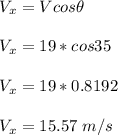
Physics, 23.04.2020 02:57 johhnyappleseed2006
A 1-kg discus is thrown with a vertical velocity of 19 m/s at an angle of 35 degrees from a height of 1.94 m. Do not factor in air resistance. Calculate the vertical and horizontal velocities.

Answers: 3


Other questions on the subject: Physics

Physics, 22.06.2019 04:40, joneil1952
Argon is adiabatically compressed from an initial volume of 16 liters to a final volume of 2 liters. by what factor do the following quantities change? do they increase or decrease? (a) the rms speed (b) the thermal energy of the gas (c) the molar specific heat cv (d) the pressure
Answers: 3

Physics, 22.06.2019 05:30, keylor97
Utah's great salt lake has an average salinity seven times higher than that of the oceans. very few multicellular organisms live in this harsh environment. an example is the brine shrimp, which must devote a large portion of its metabolic energy to osmoregulation. these brine shrimp must available hint(s)utah's great salt lake has an average salinity seven times higher than that of the oceans. very few multicellular organisms live in this harsh environment. an example is the brine shrimp, which must devote a large portion of its metabolic energy to osmoregulation. these brine shrimp must pump water back into their cells to counter its loss due to osmosisactively pump water back out of their cells to counter its inflow due to osmosissynthesize membranes that are impermeable to substances that upset osmotic balanceactively pump salt back out of their cells to counter its inflow due to osmosis
Answers: 3

Physics, 22.06.2019 17:30, Coolcatfurzy
Which basic property determines a colored light's placement on the spectrum of visible light? a. speed b. frequency c. amplitude d. velocity
Answers: 3

Physics, 22.06.2019 19:30, rprest00
Amass m = 74 kg slides on a frictionless track that has a drop, followed by a loop-the-loop with radius r = 18.4 m and finally a flat straight section at the same height as the center of the loop (18.4 m off the ground). since the mass would not make it around the loop if released from the height of the top of the loop (do you know why? ) it must be released above the top of the loop-the-loop height. (assume the mass never leaves the smooth track at any point on its path.) 1. what is the minimum speed the block must have at the top of the loop to make it around the loop-the-loop without leaving the track? 2. what height above the ground must the mass begin to make it around the loop-the-loop? 3. if the mass has just enough speed to make it around the loop without leaving the track, what will its speed be at the bottom of the loop? 4. if the mass has just enough speed to make it around the loop without leaving the track, what is its speed at the final flat level (18.4 m off the ground)? 5. now a spring with spring constant k = 15600 n/m is used on the final flat surface to stop the mass. how far does the spring compress?
Answers: 3
You know the right answer?
A 1-kg discus is thrown with a vertical velocity of 19 m/s at an angle of 35 degrees from a height o...
Questions in other subjects:

Chemistry, 03.09.2019 03:20



Engineering, 03.09.2019 03:20

Social Studies, 03.09.2019 03:20


Computers and Technology, 03.09.2019 03:20


Computers and Technology, 03.09.2019 03:20








